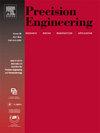A sliding-disk method for decoupled planning of five-axis tool paths in flat and filleted end milling with uniform-scallop and uniform-strip-width constraints
IF 3.5
2区 工程技术
Q2 ENGINEERING, MANUFACTURING
Precision Engineering-Journal of the International Societies for Precision Engineering and Nanotechnology
Pub Date : 2025-02-03
DOI:10.1016/j.precisioneng.2025.02.003
引用次数: 0
Abstract
Five-axis flat-end and filleted-end milling is crucial in high-efficiency machining of complex parts with curved surfaces. However, different from ball-end machining, there exists coupling influences between the scallop height, the strip width, the cutter-contact paths, and the tool-orientation paths in flat-end and filleted-end five-axis machining, which makes the toolpath planning so challenging that most existing methods cannot guarantee uniform scallop height and uniform strip width simultaneously. To deal with this problem, this paper presents a “sliding-disk” method for decoupled planning of five-axis toolpath in flat and filleted end milling, which transforms the problem of the toolpath planning into a problem of “a disk sliding on a rail”. First, the pose of the cutter is transformed into that of a “disk”. Then, the residual shape of the surface is transformed into a “rail”, where the scallop height and the strip width constraints are transformed into the constraint of the disk-rail contact status. Finally, the optimization process of the toolpath is transformed into the sliding process of the “disk” on the “rail”. By constructing the disk-rail contact constraints, the influence of cutter pose on the scallop height and the strip width can be decoupled, so that the tool-position and tool-orientation paths can be planned flexibly. By planning the “disk-sliding process”, the tool-position and tool-orientation can be optimized simultaneously towards a user-set performance index, without varying the uniform scallop height and the uniform strip width because of the decoupled property. Four groups of machining experiments are conducted to verify the effectiveness and advantages of the proposed method. It can be concluded from the experimental results that the presented method yields the most uniform scallop height and strip width, and the shortest toolpath length, when comparing with typical existing methods.
均匀扇形和均匀条宽约束下平头和倒角立铣刀路五轴解耦规划的滑动盘法
五轴平头和圆角头铣削是复杂曲面零件高效加工的关键。然而,与球端加工不同的是,平端和倒角端五轴加工中扇贝高度、带材宽度、刀具接触路径和刀具取向路径之间存在耦合影响,这使得刀具路径规划具有挑战性,大多数现有方法无法同时保证扇贝高度和带材宽度均匀。针对这一问题,提出了一种“滑盘”法对平倒角立铣刀路和倒角立铣刀路进行解耦规划,将刀路规划问题转化为“盘在导轨上滑动”问题。首先,将刀具的姿态转化为“圆盘”的姿态。然后,将表面的残余形状转化为“导轨”,其中扇贝高度和条形宽度约束转化为盘轨接触状态约束。最后将刀具轨迹的优化过程转化为“盘”在“轨”上的滑动过程。通过构建盘轨接触约束,可以解耦刀具位姿对扇形高度和带钢宽度的影响,从而灵活规划刀位和刀位路径。通过规划“圆盘滑动过程”,可以根据用户设定的性能指标同时优化工具位置和工具方向,而不会因为解耦特性而改变均匀扇形高度和均匀条形宽度。通过四组加工实验验证了该方法的有效性和优越性。实验结果表明,与现有的典型方法相比,该方法获得的扇贝高度和带材宽度最均匀,刀路长度最短。
本文章由计算机程序翻译,如有差异,请以英文原文为准。
求助全文
约1分钟内获得全文
求助全文
来源期刊
CiteScore
7.40
自引率
5.60%
发文量
177
审稿时长
46 days
期刊介绍:
Precision Engineering - Journal of the International Societies for Precision Engineering and Nanotechnology is devoted to the multidisciplinary study and practice of high accuracy engineering, metrology, and manufacturing. The journal takes an integrated approach to all subjects related to research, design, manufacture, performance validation, and application of high precision machines, instruments, and components, including fundamental and applied research and development in manufacturing processes, fabrication technology, and advanced measurement science. The scope includes precision-engineered systems and supporting metrology over the full range of length scales, from atom-based nanotechnology and advanced lithographic technology to large-scale systems, including optical and radio telescopes and macrometrology.

 求助内容:
求助内容: 应助结果提醒方式:
应助结果提醒方式:


